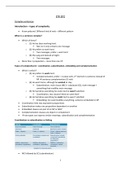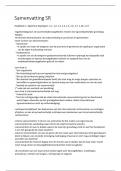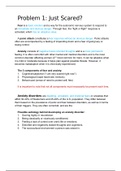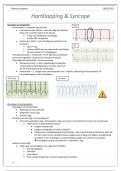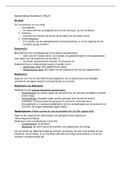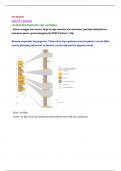Complex sentences
Introduction – types of complexity
• Know patterns! Different kind of verb – different pattern
When is a sentence complex?
• Which of these?
o (1) He has been working hard.
▪ Not, bc it only contains one message
o (2) He prefers to work hard.
▪ Two messages, prefer + work hard
o (3) She sang and danced all night.
▪ Two messages
• More than 1 proposition – more than one VP
Types of complexity (4) – coordination, subordination, embedding and complementation
• Which is which?
o (2) He prefers to work hard.
▪ Complementation, prefer = 2-place verb, 2nd element is sentence instead of
NP → sentence complementary (?) verb
o (4) He went home, although he wanted to stay.
▪ Subordination, main clause (MC) + subclause (SC), main message +
something that modifies main message
o (5) He had done everything he could, but he wasn’t satisfied.
▪ Coordination, two clauses linked on same level
o (6) He had done everything he could, but he wasn’t satisfied.
▪ Embedding: he could modifies everything, sentence embedded in NP
• Coordination links two equivalent propositions
• Subordination makes one proposition dependent on another
• Embedded clauses are part of an NP or ADJP
• Complementation clauses are object or complement
• → two types can express similar meanings: subordination and complementation
Coordination vs subordination vs linking
• MC followed by SC (subordination)
1
,Example – concessive relations
• (7) He had noticed her. However, he hadn’t paid attention to what she was reading.
o Supra-sentential
o Cannot change order without changing meaning
• (8) He had noticed her, but hadn’t paid attention to what she was reading.
o Coordination
o Cannot change order without changing meaning
• (9) He hadn’t paid attention to what she was reading, although he had noticed her.
o Subordination
o Concessive follows MC (but can also be other way around: although … he hadn’t)
How to analyse a complex sentence
Sentence 1
• Three hundred cities in 19 countries, all of them with 100,000 or more residents, reported
that they were tending to move on from measures such as parking restrictions and
pedestrian streets that control the use of cars to devices such as bus-lanes and special traffic
signals that help to improve the service offered by public transport.
• Step 1: indicate all VPs
o Reported, tending, to move, control, help, to improve, offered
• Step 2: find main verb(s), determine argument structure
o [Three hundred cities in 19 countries, all of them with 100,000 or more residents,]
reported [that they were tending to move on from measures such as parking
restrictions and pedestrian streets that control the use of cars to devices such as
bus-lanes and special traffic signals that help to improve the service offered by
public transport.]
▪ Reported: 2-place S-DO
▪ S = three … residents, DO = that … transport (not necessarily all! Can also
have ADV)
• Step 3: are any of the arguments ‘clausal’ (VP-complementation); or do any of the ‘phrasal’
arguments contain a clause (NP-complementation; ADJ-complementation) → find main verb
of subclause (that …)
• Step 4: determine the function of the subclause
• → repeat step 3 and 4 (je haalt volgende verb uit vorige analyse – inspringing = notities)
o [that…] us an ‘embedded’ clause, it complements the VP
The subclause with ‘tend’ as verb is a case of VP-complementation, it is a DO-clause
o Tend = 2-place S-PC (towards) – prep. deletion, so: the clause with ‘move’ as verb is
VP-complementation, PC-clause
▪ Tending = 2-place S-PC (towards) but because to-inf preposition is dropped
(→ to move on…)
o ‘move on’ = 1-place S only (they); other elements in the sentence are adverbials
describing a path (from X to Y)
▪ To move on: 1-place +, what follows is ADV (from, to describing path)
o ‘control’ is preceded by a linking element, that links it to ‘parking restrictions and
pedestrian streets’, which is an NP: NP-complementation
▪ (that control) = embedded, postmodifies NP parking … streets ; full NP =
parking … use of cars
2
, o ‘that help’ has a similar structure: 2-place S-PC (with sth) – VP-complementation: PC-
clause
▪ Help = S-PC (with something) → to improve … transport
o ‘to improve’ is directly preceded by ‘help’, so probably links to it directly
o ‘offered’ is non-finite – past participle (passive in meaning); it is directly preceded by
an NP – hence NP-complementation
▪ Offered: linked to ‘the service’, embedded, completes the NP
• NO direct link between form of verb and function
Exercise types of complexity p15
• Co-ordination
• Complementation (VP-complementation – object or complement clauses)
• Embedding (NP-complementation, ADJ-complementation)
• Subordination (VP-complementation – adverbial clauses)
• → Sentences syllabus:
o (2) One other aspect of the Singapore scheme merits note, since it illustrates the
way in which the new traffic management is not so much anti-car as in favour of the
more efficient use of scarce resources.
o (3) He supposed that because there was no sharp line between a moderate load and
a severe overload, there was therefore no difference between them.
o (4) The truth is that the difference between those who own capital and those who
do not is one of the most important of the social differences between men, although
there is a continuous variation between those who own nothing and those who own
a great deal.
o (5) Context is a source of meaning for every language event as it gives the reader or
hearer a frame of reference within which to interpret what has been uttered or
written.
o (6) The aim is to develop communicative competence in translation, to foster, that
is, the ability to convey messages from the SL into the TL that are not only
linguistically correct but also appropriate to the context of situation and context of
culture.
o (7) By encouraging students to interpret the communicative purpose of the source
text In its contextual setting before reformulating it into the target text, translation
enhances their awareness of how formal and functional features of language
interact both within the same language and between languages.
o (8) Translation, like all communication, is a dynamic process in which meanings are
constructed and negotiated in a series of overlapping and interactive procedures,
calling into play a variety of skills and abilities.
o (9) Finally, and to repeat an earlier claim, a communicative event is here conceived
of as comprising not only the discourse itself and its participants, but also the role of
that discourse and the environment of its production and reception, including its
historical and cultural associations.
o (10) Placing the primary determinant of genre-membership on shared purpose
rather than on similarities of form or some other criterion is to take a position that
accords with that of Miller (1984) or Martin (1985).
o (11) Stressing the primacy of purpose may require the analyst to undertake a fair
amount of independent and open-minded investigation, thus offering protection
3
, against a facile classification based on stylistic features and inherited beliefs, such as
typifying research articles as simple reports of experiments.
o (12) Although there may be overt political, religious or patriotic tracts put out in the
form of verse, the poetry that is taught, remembered, known and loved is rarely of
that kind and inevitably makes an appeal to the reader or listener so complex as to
allow no easy or useful categorization of purpose.
• → ppt
• Co-ordination
o *S4/S9: ‘and/but’ work at NP-level, not at S-level (complex NP)
o ?S8: ‘and’ works at VP-level, not at S-level (complex VP)
o S12: is … and makes (ellipsis of identical subject)
• Complementation (VP-complementation – subject-, object- or complement clauses)
o Subject clauses: S10 – Placing the …criterion; S11 – Stressing the …purpose;
o Object clauses: S3 – that […] there was therefore…; S7 – students to interpret…; S11
– the analyst to undertake…;
o Subject complement: S4 – that the difference…deal; S6 – to develop … culture; S10 –
to take … (1985).
o Object complement: S9 – as comprising…associations.
o Prepositional complement (no other e.g.)
• Embedding (NP-complementation, ADJ-complementation)
o ADJ-comp: no examples in this set
o NP-comp: (quite a lot – the following is a selection) S2 – in which…is; S4 – who
own…(etc.); S6 – that are… ; S9 – including…; S11 – based on…;
• Subordination (VP-complementation – adverbial clauses)
o S2 – since it illustrates…
o S3 – because there was…
o S4 – although there is…
o S5 – as it gives…
o S7 – By encouraging…; before reformulating…
o S9 – To repeat…
o S11 – thus offering
o S12 – Although there may be…
• → notes
• Coordination:
o S4: those who own and those who do not → coordinates two NPs (those and those)
→ coordination also works on NP level
o S12: it is rarely of that kind and inevitably makes an appeal → ellipsis S in 2nd clause
• Complementation: (clause takes place of sentence part (S, DO, …))
▪ ‘Complementation’ = sometimes used as cover term, confusing
o S4: the truth is that … men → subject complement (SC) clause, S = the truth
o S6: the aim is to develop … → SC-clause
o S7: by encouraging students to interpret … → DO-clause, you encourage sth =
students to interpret
• Embedding: (clause is part of NP or ADVphrase)
o S4: those who own capital → postmodifies ‘those’
o S8: dynamic processes in which … negotiated → postmodifies ‘dynamic processes’
• Subordination:
4


